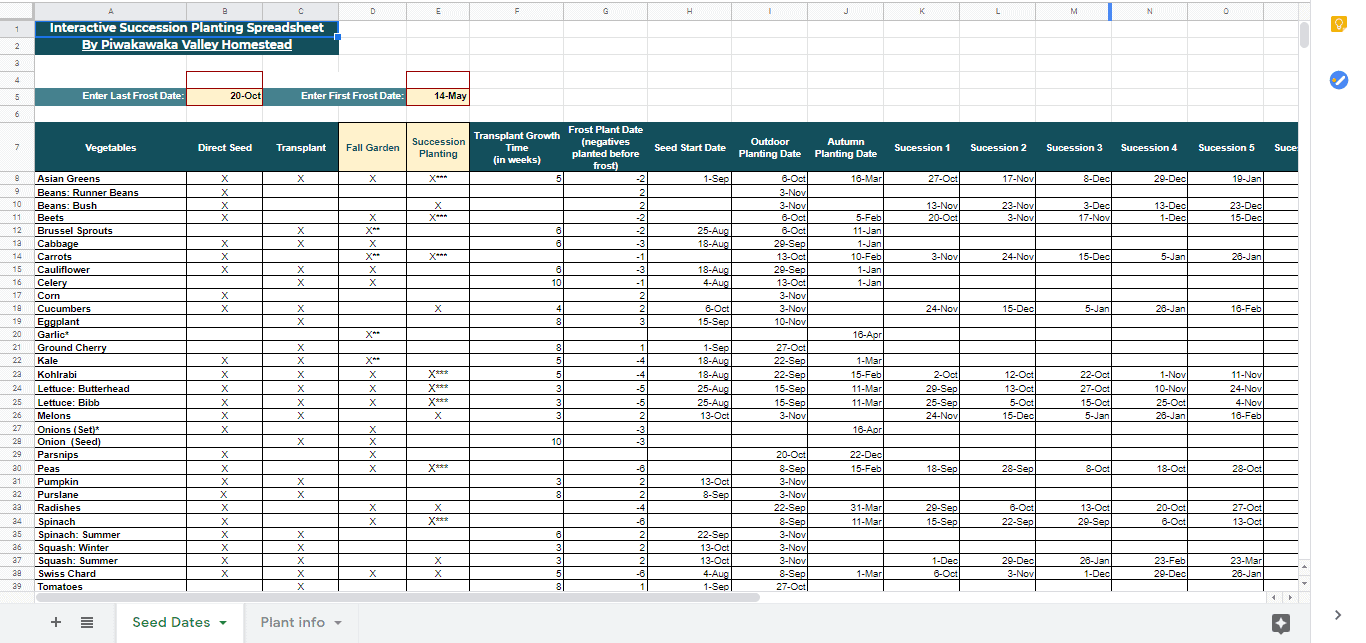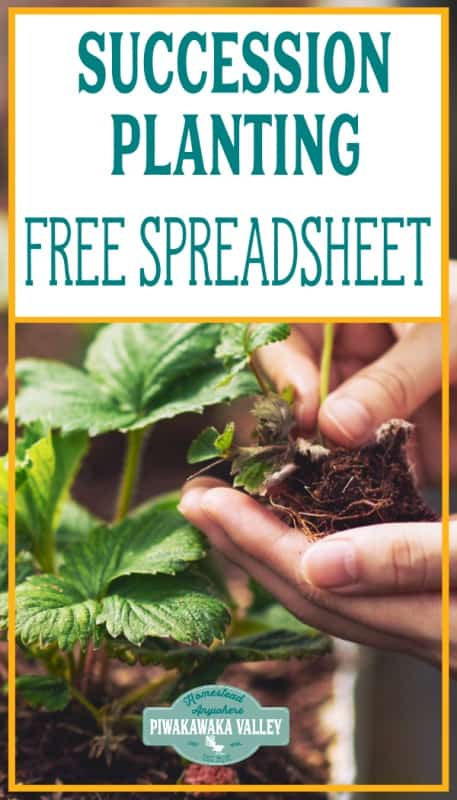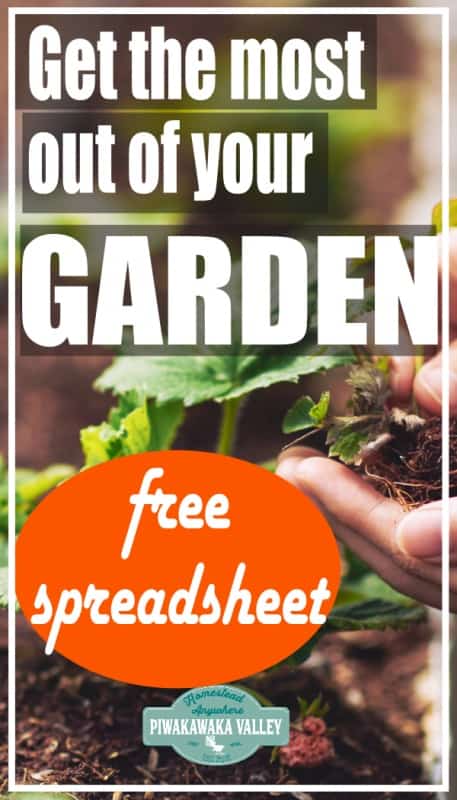This post was most recently updated on January 26th, 2021
If you are trying to get the most production and harvest out of your garden, then this succession planting spreadsheet is going to be your friend! What is succession planting? It is when you have two or more crops in succession in the garden. Ie after one crop is harvested, another is planted in the same space.
Please read: This information is provided for educational purposes only and is not intended to treat, diagnose or prevent any disease. We encourage you to make your own health care decisions in partnership with a qualified health care professional.
This post contains affiliate links, this means at no extra cost to you, we make a commission from sales. Please read our Disclosure Statement
The length of your growing season, the climate, and your crop selection are key factors in how many successions you can fit in to your vegetable garden successfully. At the top of this post is a FREE Succession Planting Spreadsheet that you can use in Google Docs.
While I was writing the Homesteaders Guide to Seasonal Gardening, I found that good, interactive planning spreadsheets were hard to come by, so I started working on this one.
If you want to learn how to garden seasonally, I recommend you check out my book here
Types of Succession Plantings
There are different ways you may choose to succession plant. Here are the main options, you can do a variety of these if you wish.
Same crop, successive plantings:
Several smaller plantings are made at timed intervals, rather than all at once. In theory the plants mature at staggered dates, giving you a continuous harvest over an extended period.
Lettuce and other salad greens as well as peas and radishes are common crops for this approach. Given that plants grow slower in the shoulder seasons (Autumn and Spring) and faster in the warmer season, you will possibly find that they overlap more than you expected.
Space out plantings of the same vegetable every two to four weeks, this is not a set timeframe and you can vary it to what suits you.
Many vegetables fade after producing their initial crop, giving a heavy harvest initially, then smaller and smaller yields throughout the summer.
Rather than planting your entire row of beans or peas all at once, you can plant part of the row at the beginning of the season and then plant more in about two to four weeks to enjoy them for much longer.
RELATED: How to plan your planting this season
Different vegetables in Succession:
Some crops, such as peas, have short growing seasons and they do better in the cooler times of the year. The space they were using can be replanted with a later season crop, like eggplant, peppers or tomatoes.
Two or more crops simultaneously:
Non-competing crops, often with different maturity dates, are planted together and harvested at different times.
This can be done in several ways – Intercropping is one option; companion planting is another.
Interplanting requires a certain amount of preplanning and knowledge of the maturity dates of different types of vegetables. Planting two or more non-competing crops may raise less issues with soil-borne diseases and insects that only affect one type of plant.
Carrots and radishes are a good example of this. You can sow them at the same time, and the radishes are harvested well before the slow growing carrots need the space.
Same crop, different maturity dates:
This is when several varieties are selected, with different maturity dates: early, main season, late. They can then be planted at the same time, the varieties mature one after the other over the season giving you a staggered harvest.
Sometimes the seed packet will be labeled as such, and sometimes you will just have to read the “days to maturity” number. Beans (pole), broccoli, Brussels sprouts, cabbage, carrots, cauliflower, celeriac/celery, collards, corn, eggplant, kale, melon, peas, summer squash, and tomatoes.can be staggered throughout the growing season this way.
What is a catch crop?
A catch crop refers to a specific type of succession planting, where a fast-growing crop is grown simultaneously with, or between successive plantings of, a main crop to make the most of the space (either physical or in time). They are kind of considered a ‘bonus crop’.
RELATED: How to prepare your garden for planting
The benefits of crop rotation in succession planting:
• Breaks the cycles of insect and disease, both above and below ground
• Biodiversity results in a diversity of root systems, which in turn brings diversity in soil life; the easiest way to improve soil quality
• Less fertiliser is required. Alternating heavy and light feeding crops means compost only needs to be applied once in the cycle, prior to the heavy feeders.
• Different plants draw on different minerals. Rotating crops prevents the same minerals being drawn from the soil, keeping soils balanced.
RELATED: Crop rotation tips and tricks
Tips for Successful Succession Planting
1. Get enough seed
Make sure you have enough seed to get you through the season and into fall if you plan to over-winter vegetables in hoop houses. Some seed lasts several years; others need to be fresh for good germination. Some varieties do run out at seed stores, so it is best to order everything you need at the beginning of the season.
2. Feed the soil well
Add some compost or leaf mold to the beds, between plantings, to keep the soil rich. An inch or two of compost on the top of the soil will keep the soil web alive and functioning.
RELATED: How to improve soil for the best growth
3. Get ruthless
Don’t hesitate to pull out vegetables past their prime. Use them while they are at their best and then use the space for something else. Chickens, pigs or the compost will all benefit from older plants, letting you have the prime plants.
4. Start seeds in stages
So many people only plant their garden once. However, for most plants you can sow a second round of them in mid-spring, when the first batch has finally been moved out.
Summer squash and cucumbers started in November or December (May or June in the Northern Hemisphere) will be ready to transplant as the first plantings planted out in early spring wind down (or get eaten by bugs).
Once these are transplanted out it is time to seed your Autumn/fall greens, such as kale and chard, to grow on indoors or in a protected area, then move into the garden in late summer for harvesting as the weather cools.
5. Start a crop rotation and succession notebook or spreadsheet
Record where and when plants are planted and when fertiliser was added. Make a note of which crops were successful and which struggled. This will all come in handy in a year’s time when you start planting again.
There are many different ways to apply crop rotation or succession plantings. Generally you should plant crops in the following order: Heavy feeder, light feeder, green crop, compost
HEAVY-FEEDING CROPS
Cabbages, cauliflowers, broccoli, Brussels sprouts, onions, leeks, garlic, melons, cucumbers, courgettes, pumpkins, tomatoes, aubergines, capsicums, chard, spinach, lettuce, corn and celery
FOLLOWED BY LIGHT-FEEDING CROPS
Root vegetables
Potatoes, beetroot, parsnips, carrots, radishes, turnips, kohlrabi, celeriac, kumara
Legumes
Peas, snow peas, beans, broad beans, edamame
Greens
Kale, mesclun, mustard greens, Asian greens, radicchio, chicory, rocket
FOLLOWED BY A GREEN MANURE
Unlike food crops that end up on our plates, green manure restore soil as the entire crop is returned to the soil, adding another layer of biodiversity.
RELATED: The best green manure and cover crops
Succession Planting Spreadsheet – A Seed Starting & Planting Interactive Calculator
Our succession planting spreadsheet is free to all who want to sign up to our newsletter.
Sign up here and you will be sent an email with the link to make a copy of your own
[et_bloom_inline optin_id=”optin_14″]
Research your average last and first frost date. I like to Google “Average Frost Dates [your location]” and look at a few sources to get the latest weather patterns.
However, if you live in the United States and do not want to research the Farmers Almanac website has a search page for that.
NZ FROST DATES
These dates are approximate, they cover the first frost on average and the last frost on average, it is always best to keep an eye on your local weather report and keep your own records for your property!
First frost in NZ
Auckland 1 June
Rotorua 10 May
Hamilton 10 May
Wellington 5 June
Christchurch 1 May
Alexandra 1 April
Dunedin 5 April
Invercargill 1 April
Last frost in NZ
Auckland 30 July
Rotorua 30 September
Hamilton 30 September
Wellington 30 July
Christchurch 30 September
Alexandra 31 October
Dunedin 20 October
Invercargill 31 October
How to use the Seed sowing and succession planting spreadsheet
There are two pages on the spreadsheet, and the areas you can influence the calculations are highlighted in yellow.
Insert your frost dates into the appropriate boxes highlighted in yellow at the top of the first page.
The given planting dates should work for most temperate climates. If you are approaching the antarctic/arctic or tropical zones will need to use techniques to either extend your season or shield cold loving crops from the heat.
Dates for succession and Autumn/Fall planting columns are triggered by you putting an X in the Autumn/Fall and Succession planting columns.
They are calculated by the first frost date, days of harvest, and recommend succession planting dates (which you can change on the second page).
If you want longer times between successions you can change the time in the second ‘Plant info’ sheet.
You might want only one or two plantings of a variety, or you might want as many as you can – so you can change this to suit.
Once you’ve got your first planting dates, you can establish the dates for starting seedlings indoors for those vegetables that you intend to transplant.
For those vegetables that only produce for a limited time, remember that you can often use succession planting to extend the harvest.
Do the above for each vegetable you’re growing and you’ve got a handy schedule for planting your garden, and if you keep notes and tweak it each year, it will only get better.
Be sure to write in your notebook what varieties you have grown and how they have done. This will help you decide which varieties to grow again next year.
If you would like help getting the most out of your garden, I would love to help you, find out more here
RELATED: Free Gardening Resources
If you like tips on frugal living, self sufficiency and consuming less, sign up to our newsletter below, I would LOVE to have you
For further reading, I really recommend all of these books. I own every one of them and they are amazing resources!
































